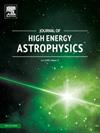The multiwavelength correlations quest for central engines of GRB plateaus: Magnetar vs black hole spin-down
IF 10.5
4区 物理与天体物理
Q1 ASTRONOMY & ASTROPHYSICS
引用次数: 0
Abstract
This manuscript presents a multilevel analysis of gamma-ray bursts (GRBs). We focus on the plateau phase, which is often observed in the light curves (LCs) of GRBs. We discuss its observational properties and then thoroughly examine possible theoretical models to explain them. Inspired by the limitations of many currently known models, we introduce a novel scenario of an LC powered by the kinetic energy of a rotating black hole (BH). We investigate observational correlations between the properties of GRBs across the gamma, X-ray, and optical bands during the prompt and plateau phases of their LCs. Our analysis includes all GRBs with known redshifts detected by the Neil Gehrels Swift Observatory (Swift) and the Fermi Gamma-ray Space Telescope (Fermi), as well as ground-based optical telescopes. We identify a tight correlation with the coefficient of ∼0.89 for the three-dimensional Dainotti relation between the luminosity at the end of the plateau, its duration measured by Swift, and the peak luminosity measured by Fermi in the 10-1000 keV band. When accounting for redshift evolution, we achieve very small intrinsic scatter ( reduction compared to the previous results). Additionally, we explore correlations involving the optical luminosity at the end of the plateau, yielding promising results. We investigate the clustering of different classes of GRBs in the investigated parameter space and discuss its impact on the aforementioned correlations as well as - correlation. Notably, we demonstrate how to use the correlations as a powerful class discriminator. Finally, we discuss the theory supporting the evidence of the plateau emission. We present a new paradigm for the GRB plateau: energy extraction from a quickly rotating black hole (BH) via spin-down by a magnetically arrested disk (MAD). We compare this model with observations and explain multiple observed features. We predict the plateau luminosity - time anti-correlation and discuss the cosmological evolution within this proposed model. Furthermore, within this new model, we discuss the possible physical origin of the clustering of long and short GRBs in the parameter space of plateau luminosity - time - prompt luminosity.
伽马射线暴高原中心引擎的多波长相关性探索:磁星与黑洞自旋下降
本文提出了伽玛射线暴(GRBs)的多层次分析。我们关注的是平台相,这是grb的光曲线(lc)中经常观察到的。我们讨论它的观测性质,然后彻底检查可能的理论模型来解释它们。受到许多目前已知模型的局限性的启发,我们引入了一个由旋转黑洞(BH)的动能驱动的LC的新场景。我们研究了伽玛、x射线和光学波段伽玛暴在其LCs的提示期和平台期之间的观测相关性。我们的分析包括所有已知红移的伽马暴,这些红移是由尼尔·格雷斯·斯威夫特天文台(Swift)和费米伽玛射线空间望远镜(Fermi)以及地面光学望远镜探测到的。我们发现高原末端的亮度、Swift测量的亮度持续时间和费米在10-1000 keV波段测量的峰值亮度之间的三维Dainotti关系与R2系数密切相关,R2系数为0.89。当考虑到红移演化时,我们得到了非常小的本征散射σint=0.25±0.04(与之前的结果相比减少了43%)。此外,我们探索了高原末端光学光度的相关性,得到了有希望的结果。我们研究了不同类型grb在研究参数空间中的聚类,并讨论了其对上述相关性以及eso - epeak相关性的影响。值得注意的是,我们演示了如何使用相关性作为强大的类鉴别器。最后,我们讨论了支持高原辐射证据的理论。我们提出了GRB平台的一个新范例:通过一个磁捕获盘(MAD)的自旋向下从一个快速旋转的黑洞(BH)中提取能量。我们将该模型与观测结果进行比较,并解释了观测到的多个特征。我们预测了平台光度-时间反相关,并在该模型中讨论了宇宙演化。此外,在该模型中,我们还讨论了长、短伽马暴在高原光度-时间提示光度参数空间中聚集的可能物理根源。
本文章由计算机程序翻译,如有差异,请以英文原文为准。
求助全文
约1分钟内获得全文
求助全文
来源期刊

Journal of High Energy Astrophysics
Earth and Planetary Sciences-Space and Planetary Science
CiteScore
9.70
自引率
5.30%
发文量
38
审稿时长
65 days
期刊介绍:
The journal welcomes manuscripts on theoretical models, simulations, and observations of highly energetic astrophysical objects both in our Galaxy and beyond. Among those, black holes at all scales, neutron stars, pulsars and their nebula, binaries, novae and supernovae, their remnants, active galaxies, and clusters are just a few examples. The journal will consider research across the whole electromagnetic spectrum, as well as research using various messengers, such as gravitational waves or neutrinos. Effects of high-energy phenomena on cosmology and star-formation, results from dedicated surveys expanding the knowledge of extreme environments, and astrophysical implications of dark matter are also welcomed topics.
 求助内容:
求助内容: 应助结果提醒方式:
应助结果提醒方式:


